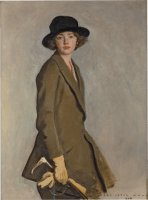This sophisticated portrait of a young woman presents Harrington Mann at his most distinguished. Depicted in equestrian attire and grasping a riding crop, the unknown sitter embodies the attitudes of a new generation coming-of-age in the roaring twenties.
The sitter has been proposed as Mann’s daughter, Cathleen Mann, who also forged a successful career as a professional artist. Cathleen was a keen rider, regularly attending hunts with her father, and in 1926 was described as a ‘fascinating brunette, who paints pictures, dances joyously and rides hard with the Bichester.’[1] Mann was a devoted father and, during the same year that this portrait was painted, transformed his studio into a ballroom, hosting a dance in honour of his wife and daughters, with a glittering guest list including Lord Chancellor and Viscount Birkenhead, Lady Phyllis and Lady Diana King.[2]
Born in Glasgow, Mann was a member of the Glasgow Boys, a group of artists who played a crucial role in introducing modern...
This sophisticated portrait of a young woman presents Harrington Mann at his most distinguished. Depicted in equestrian attire and grasping a riding crop, the unknown sitter embodies the attitudes of a new generation coming-of-age in the roaring twenties.
The sitter has been proposed as Mann’s daughter, Cathleen Mann, who also forged a successful career as a professional artist. Cathleen was a keen rider, regularly attending hunts with her father, and in 1926 was described as a ‘fascinating brunette, who paints pictures, dances joyously and rides hard with the Bichester.’[1] Mann was a devoted father and, during the same year that this portrait was painted, transformed his studio into a ballroom, hosting a dance in honour of his wife and daughters, with a glittering guest list including Lord Chancellor and Viscount Birkenhead, Lady Phyllis and Lady Diana King.[2]
Born in Glasgow, Mann was a member of the Glasgow Boys, a group of artists who played a crucial role in introducing modern art to Scotland in the late 19th century. He received his early art education at the Glasgow School of Art, where he developed a particular interest in portraiture, before continuing his education at the Slade School of Fine Art in London.
In London, Mann established himself as a prominent society portraitist and travelled the Atlantic to set up a successful studio in New York. Working internationally, he made a name for himself as a sensitive portraitist of children and became the preferred artist for parents across Great Britain and America. During the height of his career, Mann exhibited with all the prominent artistic societies including the New English Art Club, the Royal Society of Portrait Painters, the Royal Society of Painters and Etchers, and the International Society of Sculptors, Painters and Gravers, and in 1933 he wrote a comprehensive guide The Technique of Portrait Painting, which is still referenced today.
Mann’s reputation as a painter of the great and good still resonates today. His paintings are held within global institutional and private art collections, including Tate, the National Portrait Gallery, the Musée d'Orsay, and the Art Institute of Chicago.
[1] ‘Lord Queenberry’, Exeter and Plymouth Gazette. 9 February 1926.
[2] London Daily Chronicle, Friday 7 July 1922.











